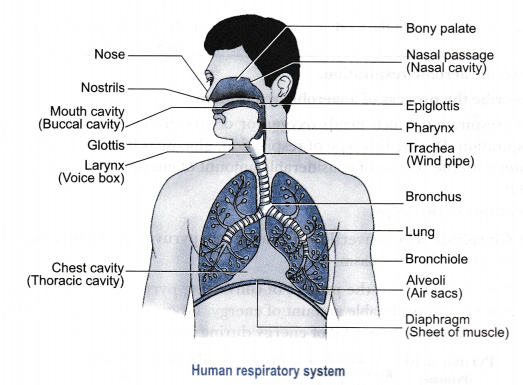Describe the Process of Inhalation and Exhalation
Inhalation is the process of intake of air into lungs whereas exhalation is the process of. Carbon dioxide is a waste product of that process.

Breathing How Do We Breathe Breathing Mechanism Types Examples
Exhalation occurs followed by the inhalation.
. Intercostal muscle role. During inspiration the diaphragm and external intercostal muscles contract causing the rib cage to expand and move outward and expanding the thoracic cavity and lung volume. During normal breathing the volume of air cycled through inhalation and exhalation is called tidal volume VT and is the amount of air exchanged in a single breath.
It then travels down the trachea to the lungs via the bronchi. During exhalation the lungs expel air and lung volume decreases. Contracts gets flattened by moving down.
Inhalation is also called inspiration. The diaphragm contracts and lowers making the rib cage expand and enlarging the thoracic cavity ad creating space for the inflating lungs. Experts are tested by Chegg as specialists in their subject area.
Inhalation is a part of breathing where the air is taken into the lungs by creating negative pressure by the contraction of respiratory muscles and diaphragm. Describe the breathing process from inhalation to exhalation in detail. Inhalation is an active process whereas exhalation is a passive process.
Oxygenated air taken in during inhalation diffuses across the surface of the lungs into the bloodstream while carbon dioxide diffuses from the blood into the lungs and is expelled during exhalation. Relaxes moves up forming a dome-shape. Expelling air out of the lungs.
Inhalation or inspiration is the process by which new air is brought into the lungs. Breathing uses chemical and mechanical processes to bring oxygen to every cell of the body and to get rid of carbon dioxide. Our body needs oxygen to obtain energy to fuel all our living processes.
To inhale the gas from the outside the pressure. Now up your study game with Learn mode. Inhalation - the chest cavity expands to make room for the expansion of the lungs.
During inhalation the lungs expand with air and oxygen diffuses across the lungs surface entering the bloodstream. When the person inhales the organ named the diaphragm contracts and simultaneously moves down. Inhalation and Exhalation During the process of inhalation the lung volume expands as a result of the contraction of the diaphragm and intercostal muscles the muscles that are connected to the rib cage thus expanding the thoracic cavity.
Upon exhalation the lungs recoil to force the air out of the lungs. Intake of air into the lungs. -lower surface of rib downward to upper surface of rib below.
The process of inhalation and exhalation Two important structures for breathing are the diaphragm and intercostal muscles. Describe the process of inhalation and exhalation. The respiratory system with its conduction and respiratory zones brings air from the.
During exhalation the diaphragm is relaxed which decreases the volume of the lung cavity. Tap again to see term. The rib cage becomes smaller as it lowers.
In the method of inspiration or inhalation there would be a contraction of muscles attached to the ribs on the outer side which pulls out the ribs and results in the expansion of the chest cavity. Exhalation - lungs deflate while the diaphragm beings to relax and rise. Click again to see term.
Size of the chest in the process. Tidal volume multiplied by the respiratory rate is minute ventilation which is one of the most important indicators of. The diaphragm and intercoastal muscle contract during the inhalation while they relax during the exhalation.
Exhalation is a part of breathing where the air is drawn out of the lungs by the relaxation of respiratory muscles. The processes of inspiration breathing in and expiration breathing out are vital for providing oxygen to tissues and removing carbon dioxide from the body. Inhalation and exhalation are how your body brings in oxygen and.
Pulmonary ventilation consists of the process of inspiration or inhalation where air enters the lungs and expiration or exhalation where air leaves the lungs. Tap card to see definition. Who are the experts.
We review their content and use your feedback to keep the quality high. Inhalation causes to increase the air pressure in the thoracic cavity whereas exhalation causes to increase it. You just studied 22 terms.
However the details of breathing between birds and mammals differ substantially. During inhalation the lungs expand with air and oxygen diffuses across the lungs surface entering the bloodstream. During inhalation the diaphragm is contracted which increases the volume of the lung cavity.
The breathing mechanism involves two processes. 11 rows It is only through inhalation and exhalation that your body brings in oxygen and expels carbon. During exhalation the diaphragm is relaxed which decreases the volume of the lung cavity.
Inspiration occurs via active contraction of muscles such as the diaphragm whereas expiration tends to be passive unless it is forced. Later the diaphragm contracts moves downwards. When it gets to the alveoli oxygen is.
Inhalation- Air is breathed in through the nose or mouth. Muxakara and 28 more users found this answer helpful.

Difference Between Inhalation And Exhalation In Tabular Form

Explain Process Of Breathing In Man Cbse Class 10 Science Learn Cbse Forum
No comments for "Describe the Process of Inhalation and Exhalation"
Post a Comment